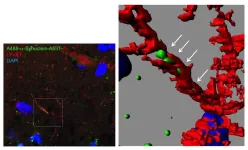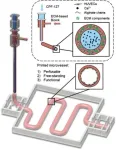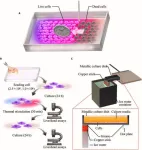(Press-News.org) A vital component of the batteries at the heart of electric vehicles and grid energy storage, lithium is key to a clean energy future. But producing the silvery-white metal comes with significant environmental costs. Among them is the vast amount of land and time needed to extract lithium from briny water, with large operations running into the dozens of square miles and often requiring over a year to begin production.
Now, researchers at Princeton have developed an extraction technique that slashes the amount of land and time needed for lithium production. The researchers say their system can improve production at existing lithium facilities and unlock sources previously seen as too small or diluted to be worthwhile.
The core of the technique, described Sep. 7 in Nature Water, is a set of porous fibers twisted into strings, which the researchers engineered to have a water-loving core and a water-repelling surface. When the ends are dipped in a salt-water solution, the water travels up the strings through capillary action – the same process trees use to draw water from roots to leaves. The water quickly evaporates from each string’s surface, leaving behind salt ions such as sodium and lithium. As water continues to evaporate, the salts become increasingly concentrated and eventually form sodium chloride and lithium chloride crystals on the strings, allowing for easy harvesting.
In addition to concentrating the salts, the technique causes the lithium and sodium to crystallize at distinct locations along the string due to their different physical properties. Sodium, with low solubility, crystallizes on the lower part of the string, while the highly soluble lithium salts crystallize near the top. The natural separation allowed the team to collect lithium and sodium individually, a feat that typically requires the use of additional chemicals.
“We aimed to leverage the fundamental processes of evaporation and capillary action to concentrate, separate, and harvest lithium,” said Z. Jason Ren, professor of civil and environmental engineering and the Andlinger Center for Energy and the Environment at Princeton and the leader of the research team. “We do not need to apply additional chemicals, as is the case with many other extraction technologies, and the process saves a lot of water compared to traditional evaporation approaches.”
Limited supply of lithium is one obstacle to the transition to a low-carbon society, Ren added. “Our approach is cheap, easy to operate, and requires very little energy. It’s an environmentally friendly solution to a critical energy challenge.”
An evaporation pond on a string
Conventional brine extraction involves building a series of huge evaporation ponds to concentrate lithium from salt flats, salty lakes, or groundwater aquifers. The process can take anywhere from several months to a few years. The operations are only commercially viable in a handful of locations around the world that have sufficiently high starting lithium concentrations, an abundance of available land, and an arid climate to maximize evaporation. For instance, there is only one active brine-based lithium extraction operation in the United States, located in Nevada and covering over seven square miles.
The string technique is far more compact and can begin producing lithium much more quickly. Although the researchers caution that it will take additional work to scale their technology from the lab to an industrial scale, they estimate it can cut the amount of land needed by more than 90 percent of current operations and can accelerate the evaporation process by more than 20 times compared to traditional evaporation ponds, potentially yielding initial lithium harvests in less than one month.
Compact, low-cost, and rapid operations could expand access to include new sources of lithium, such as disused oil and gas wells and geothermal brines, that are currently too small or too dilute for lithium extraction. The researchers said the accelerated evaporation rate could also allow for operation in more humid climates. They are even investigating whether the technology would allow for lithium extraction from seawater.
“Our process is like putting an evaporation pond on a string, allowing us to obtain lithium harvests with a significantly reduced spatial footprint and with more precise control of the process,” said Sunxiang (Sean) Zheng, study co-author and former Andlinger Center Distinguished Postdoctoral Fellow. “If scaled, we may open up new vistas for environmentally friendly lithium extraction.”
Since the materials to produce the strings are cheap and the technology does not require chemical treatments to operate, the researchers said that with additional enhancements, their approach would be a strong candidate for widespread adoption. In the paper, the researchers demonstrated the potential scalability of their approach by constructing an array of 100 lithium-extracting strings.
Ren’s team is already developing a second generation of the technique that will enable greater efficiency, higher throughput, and more control over the crystallization process. He credits the Princeton Catalysis Initiative for providing critical initial support to enable creative research collaborations. Additionally, his team recently received an NSF Partnerships for Innovation Award and an award from Princeton’s Intellectual Property (IP) Accelerator Fund to support the research and development process, including ways to modify the approach to extract other critical minerals in addition to lithium. Together with Kelsey Hatzell, assistant professor of mechanical and aerospace engineering and the Andlinger Center for Energy and the Environment, Ren also received seed funding from the Princeton Center for Complex Materials to better understand the crystallization process.
Zheng is leading the launch of a startup, PureLi Inc., to begin the process of refining the technology and eventually bringing it to the wider marketplace. Zheng was selected as one of four researchers in the inaugural START Entrepreneurs cohort at Princeton, an academic fellowship and startup accelerator designed to foster inclusive entrepreneurship.
“As a researcher, you know firsthand that many new technologies are too expensive or difficult to scale,” Zheng said. “But we are very excited about this one, and with some additional efficiency improvements, we think it has incredible potential to make a real impact on the world.”
The paper, “Spatially Separated Crystallization for Selective Lithium Extraction from Saline Water,” was published online Sep. 7 in Nature Water. In addition to Ren and Zheng, authors include Howard Stone, Fernando Temprano-Coleto, Nan Yao, Guangming Cheng, and Meiqi Yang of Princeton University; Xi Chen, formerly of Princeton University who is now an associate professor at Tsinghua University; and Liangbing Hu and Qi Dong of the University of Maryland.
END
Revolutionizing lithium production on a string
2023-09-07
ELSE PRESS RELEASES FROM THIS DATE:
Genetic study of blood glucose levels calls for stratified treatment with GLP-1R agonists in type 2 diabetes, reveals the role of the intestine, and impact on lung function
2023-09-07
New research highlights that genetic background can affect individual responses to GLP-1R agonist drugs.
Researchers reveal for the first time that high blood sugar levels in type 2 diabetes can play a causal role in lung disorders.
The study sheds light on the role of the digestive system, including the small intestine, ileum, and colon, in controlling blood sugar levels.
This is the largest-ever study into the genetic basis of random "round-the-clock" blood sugar levels.
Groundbreaking research published today in Nature Genetics describes the largest-ever study into the genetics of random "round-the-clock" ...
Bursting air bubbles may play a key role in how glacier ice melts, Oregon State research suggests
2023-09-07
CORVALLIS, Ore. – Oregon State University research has uncovered a possible clue as to why glaciers that terminate at the sea are retreating at unprecedented rates: the bursting of tiny, pressurized bubbles in underwater ice.
Published today in Nature Geoscience, the study shows that glacier ice, characterized by pockets of pressurized air, melts much more quickly than the bubble-free sea ice or manufactured ice typically used to research melt rates at the ocean-ice interface of tidewater glaciers.
Tidewater glaciers are rapidly retreating, the authors say, resulting in ice mass loss in Greenland, the Antarctic Peninsula and other glacierized regions around the globe.
“We ...
A secret passage for mutant protein to invade the brain
2023-09-07
Researchers from Tokyo Medical and Dental University (TMDU) show that the protein involved in Parkinson’s disease, α-synuclein, can propagate through the lymphatic system of the brain before it aggregates
Tokyo, Japan – In many neurodegenerative disorders, abnormal proteins progressively aggregate and propagate in the brain. But what comes first, aggregation or propagation? Researchers from Japan share some new insights about the mechanism involved in Parkinson’s disease.
In a study published ...
The need to hunt small prey compelled prehistoric humans to produce appropriate hunting weapons and improve their cognitive abilities
2023-09-07
A new study from the Department of Archaeology at Tel Aviv University found that the extinction of large prey, upon which human nutrition had been based, compelled prehistoric humans to develop improved weapons for hunting small prey, thereby driving evolutionary adaptations. The study reviews the evolution of hunting weapons from wooden-tipped and stone-tipped spears, all the way to the sophisticated bow and arrow of a later era, correlating it with changes in prey size and human culture and physiology.
The researchers explain: "This study was designed to examine a broader unifying hypothesis, which we proposed in a previous paper published in ...
Bioprinting methods for fabricating in vitro tubular blood vessel models
2023-09-07
A review paper by scientists at the Chonnam National University summarized the recent research on bioprinting methods for fabricating bioengineered blood vessel models. The new review paper, published on Aug. 1 in the journal Cyborg and Bionic Systems, provided an overview on the 3D bioprinting methods for fabricating bioengineered blood vessel models and described possible advancements from tubular to vascular models.
“3D bioprinting technology provides a more precise and effective means for investigating biological processes and developing new treatments than traditional 2D cell cultures. Therefore, it is a crucial tool ...
Titanium culture vessel presenting temperature gradation for the thermotolerance estimation of cells
2023-09-07
Hyperthermia is a potentially non-invasive cancer treatment that capitalizes on the heat intolerance of cancer cells, which are more sensitive than normal cells. In order to induce effective hyperthermia, it is necessary to apply the appropriate temperature according to the cell type, i.e., to comprehensively study the thermal toxicity of the cells, which requires accurate regulation of the culture temperature. Researchers from Keio University in Japan have developed a cell culture system with temperature ...
1 in 2 patients had better blood pressure control after using remote, bilingual program
2023-09-07
Research Highlights:
More than half of adults (55%) with uncontrolled blood pressure who enrolled in a digital monitoring program that connected patients with clinical advice and included a bilingual app paired with at-home blood pressure monitors had controlled final blood pressure measurements after participating for least 90 days.
Patients using the Spanish-language version of the digital monitoring program demonstrated more improvement in blood pressure control than patients who used the English-language version.
Embargoed until 6:30a.m. CT/7:30 a.m. ET Thursday, Sept. 7, 2023
BOSTON, Sept. 7, 2023 — Over half of patients ...
High blood pressure while lying down linked to higher risk of heart health complications
2023-09-07
Research Highlights:
An analysis of data from a long-running study of more than 11,000 adults from four diverse communities in the United States has found that adults who had high blood pressure while both seated upright and lying supine (flat on their backs) had a higher risk of heart disease, stroke, heart failure or premature death compared to adults without high blood pressure while upright and supine.
Adults who had high blood pressure while lying supine but not while seated upright had similar elevated risks of heart attack, stroke, ...
Cold weather may pose challenges to treating high blood pressure
2023-09-07
Research Highlights:
An analysis of electronic health records for more than 60,000 adults in the United States found that systolic, or top-number, blood pressure rose slightly during the winter compared to summer months. The health records were of adults being treated for high blood pressure from 2018 to 2023 at six health care centers of varying sizes located in the southeast and midwestern United States.
The researchers found that, on average, participants’ systolic blood pressure increased by up to 1.7 mm Hg in the winter months compared to the summer months.
They also found that population ...
Community-based, self-measured blood pressure control programs helped at-risk patients
2023-09-07
Research Highlights:
Community health centers participating in the National Hypertension Control Initiative (NHCI) that introduced self-measured blood pressure interventions to their patients — including individuals from Black, Hispanic and American Indian/Alaskan Native populations, who are disproportionately impacted by hypertension and by the COVID-19 pandemic — experienced improvements in blood pressure control rates since 2021, when NHCI began.
Community Health Centers in the NHCI that received funding from the U.S. Department of Health and Human Service’s Health Resources and Services Administration and Office of Minority Health and ...






